Dumbo - Tolerance Of Self
Thoughts On: Dumbo
An elephant is born with oversized ears, an apparent flaw in character, but, in the end, a hidden strength.
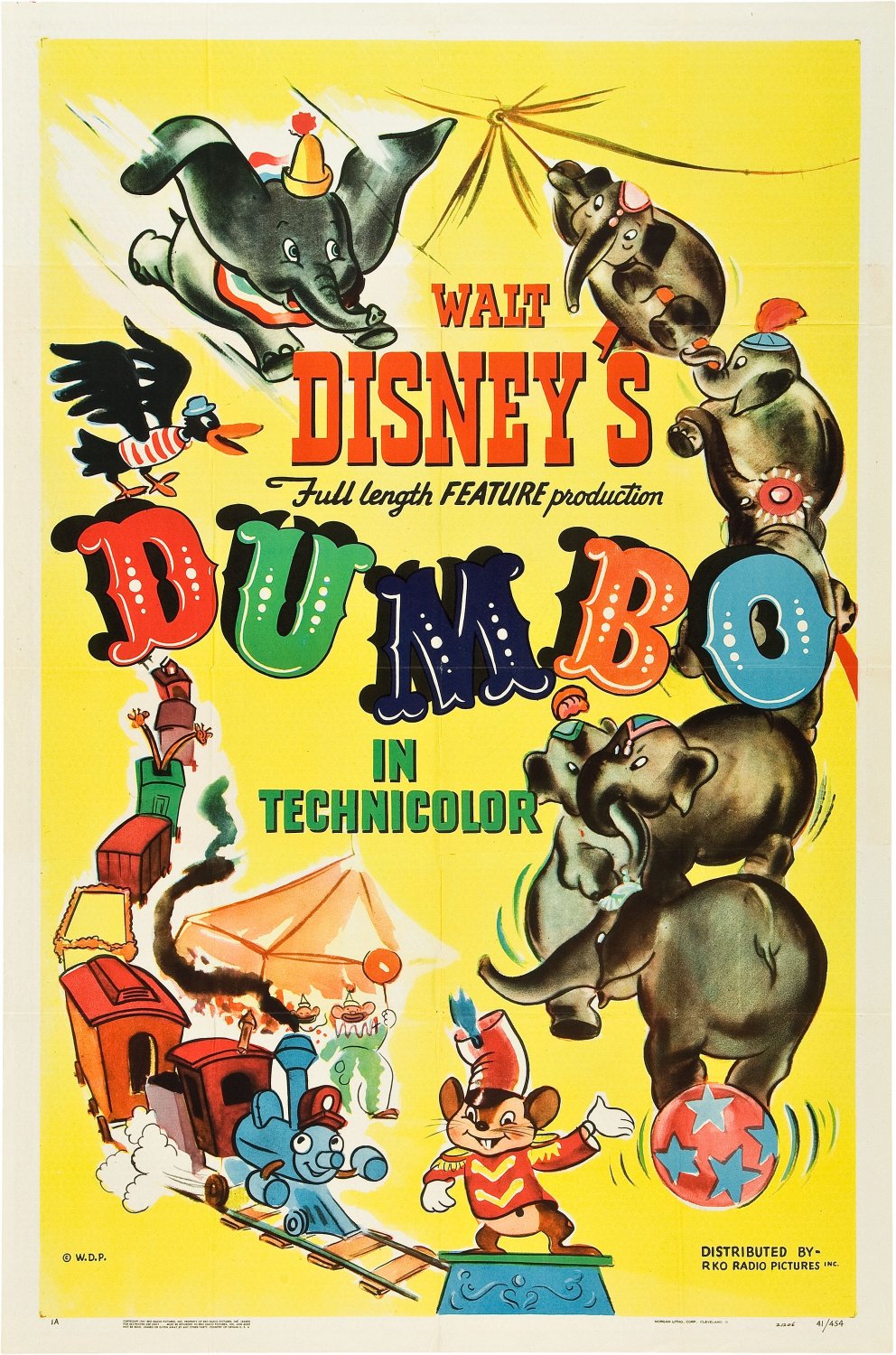
Ok, I want to start off with the claim that this is a racist film. Examples of this criticism can be found by following these links...
I'm sure there's a lot more out there, but they paint the picture. Either way, Dumbo is not racist, not at all. You have to be absurdly stupid to see that. There are elements of racism in this film with the black workers and so on, but, this, in no way, makes the film racist. All you have to do here is look at Spike Lee's classic Do The Right Thing.

There's insurmountable racism in this film - but that doesn't make it racists, it's trying to comment on themes of society and tolerance. The only reason why you'd make the claim that characters are racist, or that the film, Disney, or whatever, is, would be that you have a blind pessimistic agenda, or you're just trying to get as many views and clicks as possible with a catchy title such as '6 Disney Films That Are Undeniable Racist And Sexist'. I've been watching these films my whole life and in no way have I been offended in the slightest. The claims made in the links all lack explanation, or a detailed analysis of the film and context. Without context, anything can be offensive - just look at comedy. So, what we're going to do here is what no one else has been bothered to do. We're going to look at why certain 'racist' elements are in this film, why they are there, and what they mean.
Before we start, Dumbo is clearly a film about rising up, about being different, about being marginalised. It's because of this that I think it's so absurd to label the film racist when it's tonally uplifting in every respect. Let's not get into a rant, but jump straight into things. The most coherent way to do this is to go through the film chronologically, so, we open up on a storm, hail, rain, wind, thunder, lightning. This juxtaposed with the storks - babies - is a symbol of struggle. This may be the struggle of birth itself, but possibly the hard life these animals may endure. What is most sensical however is to see the storm as representative of a harsh world. This is reinforced with the overlaying song and its lyrics, 'you may be poor or rich, it doesn't matter which, millionaires, they get there's like the butcher and the baker. So look out for Mr. Stork'. This is obviously an allusion to sex (how you make babies - just in case you didn't know). But, what it does is reduce all people to humans, seeing them in equal light. We see this again with 'don't try and get away, he'll find you in the end'. This sounds a little scary out of context, but merely implies that the need for family, love and so on is inherent to being a person. What this then sets up is a harmonious view of people in face of a storm - the tough world. In the very opening we see tolerance, and a humane perspective of equality. Not a great opener for a racist film.
Next we move into the zoo, seeing animals have their children delivered to them. What's most interesting about this is the animals themselves, the fact that this is a movie that entirely focuses on them and not humans. The only two humans we see in any detail are the ringmaster and the asshole kid:
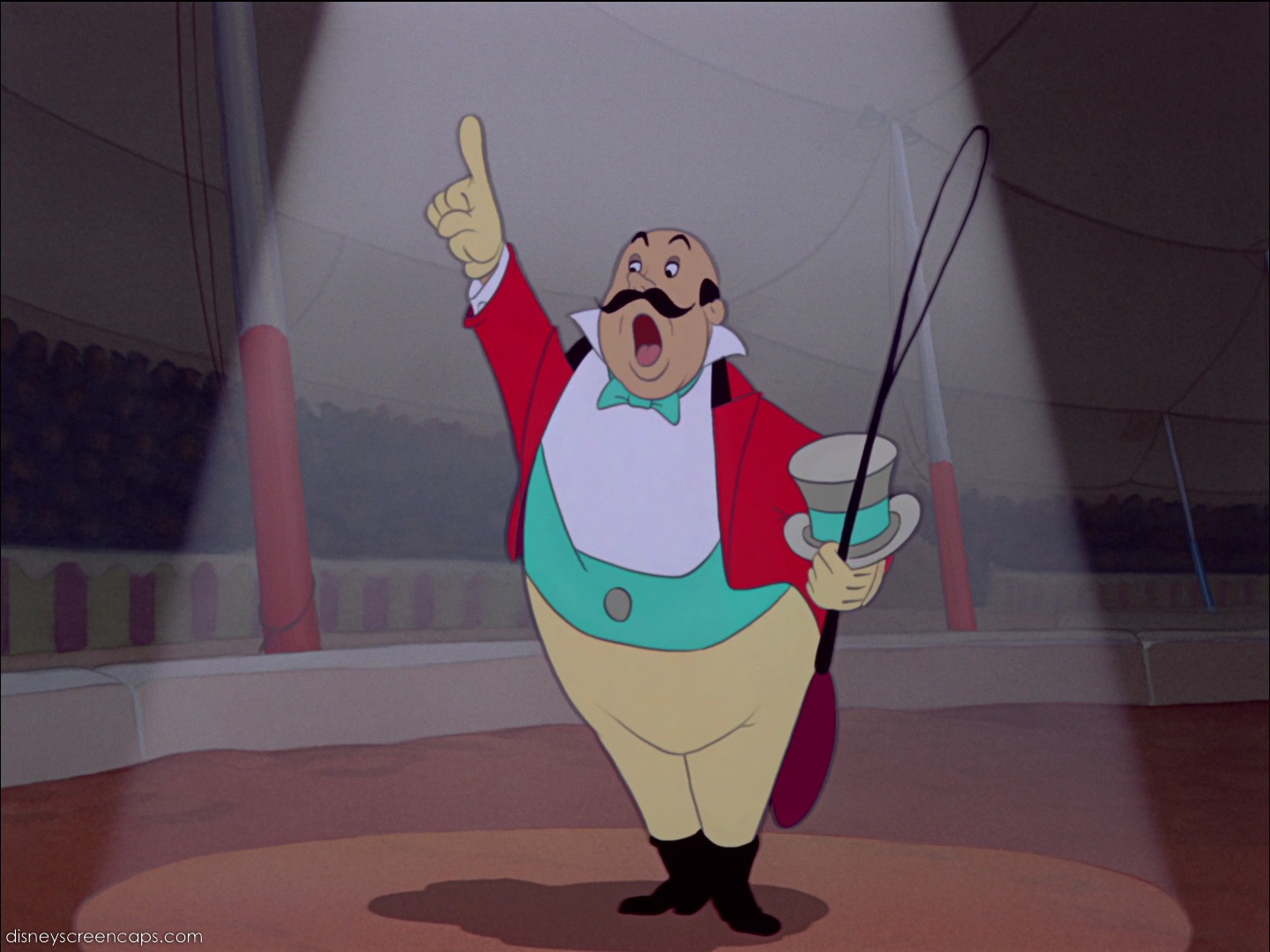

Everyone else is blurred or in very little detail:

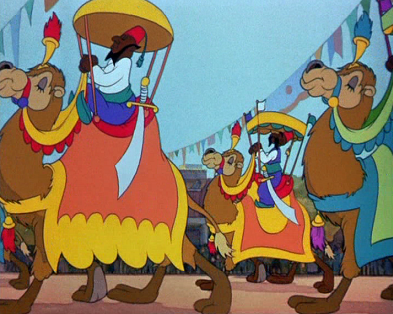
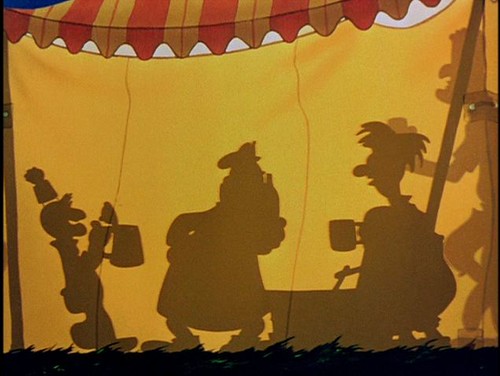
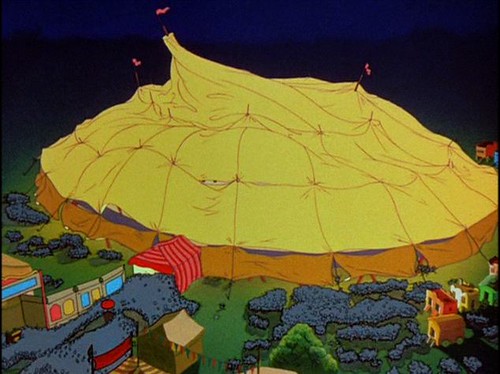
This may be attributed to production issues, with Fantasia not being very successful at all. It actually postponed production of Bambi, pushing Dumbo forward because it could be made cheaper. But, I think the detail (or lack thereof) with humans also says a lot about the film's intentions. It says that animals are what matter. This isn't a commentary on animal rights and circuses here, but minorities. The animals are used in the same capacity they are in Zootopia. They represent humans not as these things with two arms, two legs, and a head that walk upright. Animals are used to, metaphorically, make clear diversity and an idea of individuality. Again, not a wise decision for a racist film.
So, pushing on we come to the delivery of Dumbo. He is late for both comical and subtextual reasons that we'll get into momentarily. First, let's look at the small scene with the cloud and dumbo falling through. Again, comical, but also a metaphor. Dumbo's key symbol is of height (which will become all the more clearer as we progress) and to start the film at the highest point - the 'heavens' - is to possibly foreshadow a fall. This is emphasised with Dumbo sinking through the cloud. This may represent his social buoyancy or his precarious place in a higher position of social hierarchy. In other words, he has a lot of potential, and the small family of elephants eagerly await what they think is a perfect baby. For him to fall through the cloud as a result adds stakes, making clear that Dumbo's in for a rough ride. This allows us to move onto the elephants themselves.
We'll start with Dumbo's mother. The greatest thing about her character is of her silence. Before you start, no, this is not sexist. What this emphasises is the elements of silent cinema imbued throughout the film. To understand how this works and what this means I recommend checking out essays on Sunrise: A Song Of Two Humans or Chaplin's The Kid. But, to make the point briefly, her silence makes the emotion of her performance all the more poignant. However, there are other reasons for her silence. Again, we can look at the cheap production, and time saved in not voicing her charcater. But, what makes most sense is to look at the only words she says 'Dumbo, Dumbo Jr.' and how she signs for his delivery:
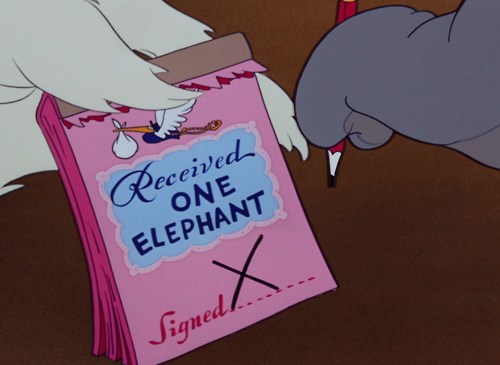
Her only words being her son's name, shows the importance of him to her, but also her inarticulation - that fact that maybe she can't speak, maybe she is dumb. This idea is reinforced by the signature as she probably can't write either. You could say this is down to the fact that she's just an elephant, but come on, a stork just sang a song, delivered a baby elephant... you get the point. Symbolism is all. Understanding that Dumbo's mother isn't very well educated, we can also infer that the circus is representative of poverty in a certain sense - of hard work with little pay. And so a theme of social class is introduced into the film, that mixes in well with themes of ethnicity and minorities. To get into these themes, we come to Dumbo and his ears. They are of course large, whereas his mother's and the other elephants' are small. This is a symbolic image of a simple difference, but also has solid ground too. There are two main types of elephant, African and Asian:
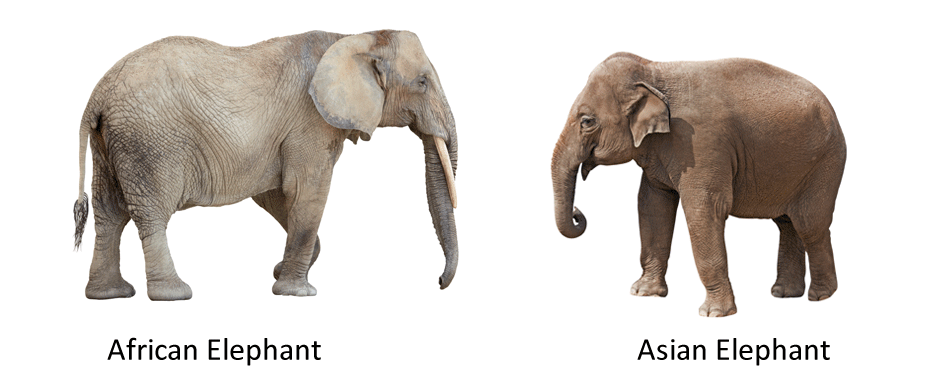
The easiest way to tell the two apart is by the ears. Notice that Asian elephants have smaller ears and African elephants have larger ones. This in turn suggest that Dumbo is an African elephant and his mother is Asian. What then comes of question is how this happened. In short, African and Asian elephants cannot crossbreed due to major genetic differences. The only known hybrid ever produced died shortly after birth. To find out more about the differences between the two species click here. But, in the context of the film, of fantasy, maybe Dumbo was adopted(?), maybe his mother bred successfully with an African bull. It's with the latter interpretation that we may understand why Dumbo was late - trouble at birth possibly. But, either way, Dumbo is a different kind of elephant - this is what is of most significance. Him being African is something we'll return to, but isn't of dire importance in understanding the message of the film. However, the use of a circus (slavery almost) as well as African and Asian animals connotes an aspect of colonialism, of white people...


... being above black, brown, whatever people. For the white guys in this case to be the bad guys... well, not a great decision for a racist (toward black and other coloured people) film. Anyways...
We can move swiftly forward with this idea, seeing that animals and minorities are the ones who work, which is where the 'racist scene' comes in. Whilst it is questionable (though, personally, not offensive at all) as to why there are only black people doing manual labour, it's also the animals that are working through the stormy night. They are the focus, they are also the ones dealing with the harsh world, as made clear by the next day when they all awaken in captivity, bored and fatigued. Moreover, there is an huge element of pacification, of conditioning, seen in these animals, especially with the gorilla and the camel. The camel swallows its spit and the gorilla screws its bar back into place having shaken it loose. These animals have been domesticated, put under the control of others - this is Disney's commentary on the scene before. There is no criticism, there is no shaming, there is no negative portrayal of minorities here - I don't see what makes it racist.
This brings us to the main themes of the film, there's pride, race and dignity. The other elephants revere these ideas, eventually disowning Dumbo because of them - because he is not like them. They essentially do what the asshole kid up top does. They criticise someone similar to themselves for apparently irrational reasons. What I mean here is that the ginger, buck-toothed, ass-face has huge ears. What gives him to confidence to mock an elephant we'll never know. And this is summarises the critique of racism. It's shown to be irrational, that there are, again, inherent links between all people. It's fear of surface level differences that fuel racism - and this is where Timothy, the mouse steps in. It's because he is so small that he freaks the other elephants out. But, like Dumbo he is the little guy, he is alone - and this is what brings them together.
Having established an idea of fear and of irrationality within larger spheres of minorities and social hierarchy, we come to the elephant's first performance and the ringmaster's epiphany. Here is where the film dips deeper into its subtext, opening up apparent plot holes. The ringmaster has a vision of a pyramid, a pyramid of pachyderms - something quite obviously impossible--and with mammals that can't even jump. Now, I know we're already quite a way into a film with talking animals, but it is easy to call bullshit on this. However, this not a plot device designed to be sensical, but strengthen the narrative message. What the ringmaster is foreseeing is a symbol of hierarchy - I mean, a pyramid of pachyderms, right? For Timothy to step in here and suggest Dumbo is the climax, that the runt can jump to the top of the pack, is tantamount to an american dream of sorts - of any kind of hopeful thinking really. What Tim's plan consists of is bringing Dumbo up through the ranks of society, to showcase his true potential, his true self that is worthy of love, success and so on. This is all a little fanciful, I accept that, but I think it's also pretty easy to accept a positive story once in a while. So, having planted the seed, Timothy preps Dumbo for the jump whilst the ringmaster preps the audience. What's most interesting about this image...
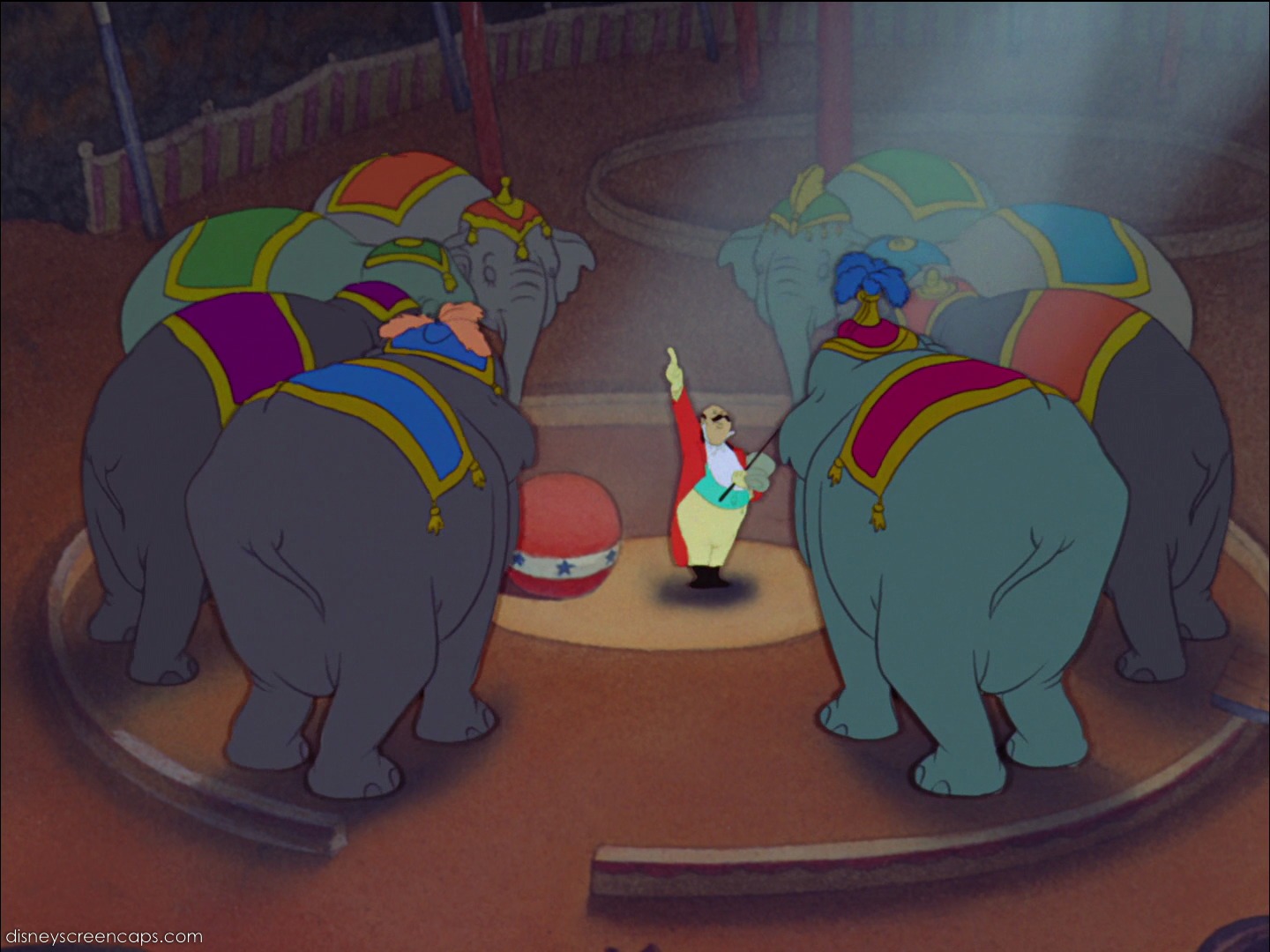
... is the ball. Not only is this stunt physiologically impossible, not only has this stunt never been practiced by these elephants, but the ringmaster decides to stage it on a ball. WHAT!? WHY!? In terms of sense, outside of fantasy and subtext, this is utterly ridiculous. But what is being set up here is a plan doomed to failure. This is the irrational dream of an idiot wanting to make money, a better name for himself at the expense of others. The ringmaster is willing to make everything all the more harder for the purpose of an audience. And so, in this the real enemy, the real conflict of the film is presented. It's the nameless, the faceless, the humans. The audience represents an idea of facade, of a character without character. This then makes clear why people are never shown in detail - as discussed in the previous part. And of course, the culmination of this insanity is disaster, both literally and metaphorically. Dumbo fails to prove himself, he fails to climb social ranks because of his ears and as a result he's socially exiled.
Having failed to reach new heights Dumbo is literally made out to be the fall guy. Here, what becomes most clear is height as a symbol of social stature. In the beginning, with the cloud sequence, Dumbo is implied to have descended from the heavens. For him to sink through the cloud is what foreshadows both the aforementioned disaster and now this...

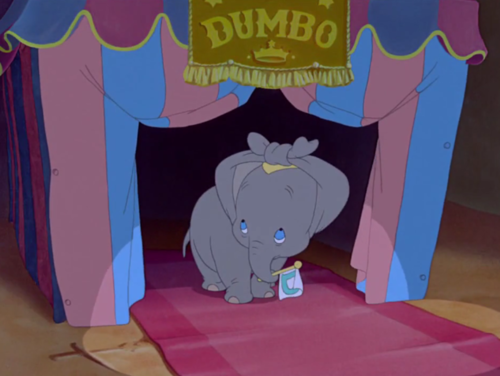
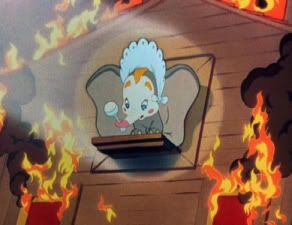
Height is an image of precariousness, of danger, of a fall in all senses of the word. And to reinforce this idea, he is made out to be a clown. In this, Dumbo being both the fall guy and a crowd's fool, it's made all too clear that the world exploits him, constantly manipulates, leaving him nothing, a shell - success an empty idea. And so from here comes plans from the other clowns of pushing the exploitation, of wanting to drop Dumbo from greater heights - and all in the name of entertainment. What this begins to suggest is the aspect of human nature that measures itself off the idea of others. When you're alone, sitting at home, reading and analysis of Dumbo, you may be miserable, happy, numb, whatever. But, say someone sits next to you and they are 3 times more miserable, 4 times happier, comatose with abject senselessness - utterly numb - it changes the way you see the world, right? It's the infamous underlying mechanism behind reality T.V. You want to see a better life than yours to make you feel miserable. You want to seeing absolute ruin to make you feel a bit better. Dumbo, caked in white makeup, holding a rattle, stood dozens of feet above the ground is Tanisha, arms crossed, feet tapping, biting her lip, waiting... 'he is not the father of your baby'.... YEAH!! And then L.G's on his feet, celebrating, break dancing, Tanisha embarrassed, unable to do much more than shake her head. Maybe that was a little racist, but all for the next point. The white makeup? And with Dumbo still being and African elephant... I don't know, what's going on here, right? Well, what we're seeing is the manipulation of Dumbo's image yet again. He's made to look more human, more like the audience waiting to see him fall - and all so they can better attribute themselves to him, waiting for the SPLASH so they can let loose a sigh of relief knowing that was not them who made the mistake of coming onto T.V to be made the fool of - or in better context, smash into a pool of custard. Moreover, to make Dumbo look like a baby is in part sadistic to a weird degree, but is also a spit in the face. For him to be a baby, but comically, insinuates he looks nothing like one. And of course, he's no more than a month or two old, so, again, manipulation of character, Dumbo is being told who and what he is. I mean, I'm calling him Dumbo, right? That's not his name. His name is Jumbo Jr.
To be embraced by his true character as nothing more than a baby with the weight of the world on his shoulders Dumbo retreats to his mother in one of the most touching scenes of all time. Undeniable cinematic beauty, irrefutable perfection. It's this acceptance of character, that marks the turning point of the narrative, and which also brings us to the most surreal scene Disney has ever produced. To dive into this, because it most definitely has meaning, I think it's best to start off by seeing it quickly...
The first thing to ask here, is why pink elephants? Well, the answer seems to stem from the idea that its common to hallucinate seeing pink elephants when drunk. Now, I'm not sure about this at all, but its what Google said, so, what I'm going to rely on instead is personal interpretation here. The elephants being pink may imply an idea of manipulation of character again. This is best understood through the apparency of them being balloons -blow up things. They are toys meant to entertain, just like Dumbo, stood before an expectant audience. Before diving deeper, yes, Dumbo is drunk here. The film has been often criticised as showing this as a solution to your problems (with Dumbo realising he can fly after this). This is perfectly valid criticism, but to look at this film, not a kid's movie, but simply a piece of art, the alcohol doesn't seem to solve problems, but push Dumbo lower, into the depths of depression and thought. And from this is he emerges all the better. To understand why, we have to dive into the sequence.
We start with pink elephants and music. This is a call back to the circus of, expectation and a performance - making clear why this is a 'parade'. What also needs to be made clear is that the elephants here all stem from Dumbo's concept of his people - of elephants such as his mother, and especially the group he was expelled from. The other female elephants not only parade a facade to entertain, but uphold an idea of race and pride. Dumbo however sees them as stepping on and over one another - which explains the early imagery of elephants squashing, merging, hitting. After this we get a lot of ghostly imagery, implying that the society of elephants haunt Dumbo - each other even. This culminates in them surrounding a symbol of rest and comfort - a bed. More haunting imagery comes with the worms and 'Technicolor pachyderms'. This breaks the fourth wall a little pointing the finger at the audience with Technicolor, implying that we are like what is being discussed. We are the elephants. We watch one another's pain for entertainment, to empathise, sympathise, feel better about ourselves. And what this all makes clear is that this is not a commentary on elephant society, but human society. We are the ones who can be fake, step over one another - and all to seem like better people. What happens next is the incorporation of early themes of race and identity with the shift to a more Eastern style of music, pyramids and dancing... things... this:

There's an argument of sexuality, and phallic imagery here (if you look at the trunks, snakes and so on), but I'm not sure its grounded. There is however an idea of attraction and of affection (encompassed by the image of the single eye) which soon comes into play. But what the return to race based themes does is remind us that Dumbo is an African elephant and every other elephant he knows is Asian. What Dumbo is then made clear to be contemplating is his place in elephant society - where he belongs. Next, we come to a theatre production, a show, a dance. This is where the idea of affection comes in. Elephants dance, but seem to be using one another, as captured by the image of stairs. We shouldn't get caught up in this idea though, as using people isn't always a bad things - especially when tables are balanced in a mutual way. This is why there's a shift from cold to hot, to show that elephants do get along, that maybe there's sanity in what ensues: industrialisation, society at large. And with an explosion, everything is over. The pink elephants, an idea of society, settles into pink clouds. Dumbo finds his epiphany and it is of tolerance. He sees society as fake, chaotic, surreal even - but in the end, simply what is. And with this acceptance comes the scene with the black birds.
We went over this before, but I'll say it again, this maybe seems racist - but I don't think it is. All we have here are a group of black men acting in a stereotypical manner. Stereotypes may not be exactly accurate in all cases, they are broad statements, but we're dealing with a film of archetypes. The birds are archetypal, snappy black guys. I mean, they're pretty cool though, right? I don't know, I don't want to argue the point. What I do want to bring back is what was recently brought to the forefront and that is Dumbo in association to race. Remembering that Dumbo may represent a black person, an African, for him to encounter these African American birds pushes the theme of tolerance. At first they see him as a stranger, someone out of place, just like the other elephants did, but with an appeal to morality with Tim presenting himself as a preacher (? - heavy stereotyping, I know) they see the connection between them all - and so, they help him to fly. But, hold on, we skipped something. How did Dumbo get up in the tree in the first place? Physically, well, he flew. But, in terms of narrative message, he had an epiphany of tolerance in his hallucination. This gave him the confidence to start climbing social ranks - and ends him up on that insanely high platform, caked in makeup, ready to fall and splash down again. However, he's got a tool this time - a magic feather. What this represents is an idea of culture, of there being something magic about being black - specifically an African American. Hold on to your hats though, and let Dumbo jump... he drops the feather. This drains his confidence. He doesn't identify as a crow, as an African American. In this sense, he's no longer faking an identity to feel included. However, this leaves him in a crisis, the ground below screaming closer, humiliation, possibly death looming.
But of course, Dumbo flies and in doing to exacts his revenge, asserting his place upon all who wronged him. What this all means is Dumbo had to accept himself. His success, his greatness was achieved by not pretending to be a crow, by not pretending to be an Asian elephant, a clown - he flies because that's the advantage his ears give him. And in that, we have conclusivity - a horrible end to a racist film. In the end, Dumbo is about being you, finding it hard to do so, but managing, thriving having found the way to do so. The film is that simple, but nonetheless, poignant. What do you think? Comment below.
Previous playlist:
Pulp Fiction - Writing Evil That Immerses
Next playlist:
Requiem Series
More from me:
amazon.com/author/danielslack

Ok, I want to start off with the claim that this is a racist film. Examples of this criticism can be found by following these links...
I'm sure there's a lot more out there, but they paint the picture. Either way, Dumbo is not racist, not at all. You have to be absurdly stupid to see that. There are elements of racism in this film with the black workers and so on, but, this, in no way, makes the film racist. All you have to do here is look at Spike Lee's classic Do The Right Thing.

There's insurmountable racism in this film - but that doesn't make it racists, it's trying to comment on themes of society and tolerance. The only reason why you'd make the claim that characters are racist, or that the film, Disney, or whatever, is, would be that you have a blind pessimistic agenda, or you're just trying to get as many views and clicks as possible with a catchy title such as '6 Disney Films That Are Undeniable Racist And Sexist'. I've been watching these films my whole life and in no way have I been offended in the slightest. The claims made in the links all lack explanation, or a detailed analysis of the film and context. Without context, anything can be offensive - just look at comedy. So, what we're going to do here is what no one else has been bothered to do. We're going to look at why certain 'racist' elements are in this film, why they are there, and what they mean.
Before we start, Dumbo is clearly a film about rising up, about being different, about being marginalised. It's because of this that I think it's so absurd to label the film racist when it's tonally uplifting in every respect. Let's not get into a rant, but jump straight into things. The most coherent way to do this is to go through the film chronologically, so, we open up on a storm, hail, rain, wind, thunder, lightning. This juxtaposed with the storks - babies - is a symbol of struggle. This may be the struggle of birth itself, but possibly the hard life these animals may endure. What is most sensical however is to see the storm as representative of a harsh world. This is reinforced with the overlaying song and its lyrics, 'you may be poor or rich, it doesn't matter which, millionaires, they get there's like the butcher and the baker. So look out for Mr. Stork'. This is obviously an allusion to sex (how you make babies - just in case you didn't know). But, what it does is reduce all people to humans, seeing them in equal light. We see this again with 'don't try and get away, he'll find you in the end'. This sounds a little scary out of context, but merely implies that the need for family, love and so on is inherent to being a person. What this then sets up is a harmonious view of people in face of a storm - the tough world. In the very opening we see tolerance, and a humane perspective of equality. Not a great opener for a racist film.
Next we move into the zoo, seeing animals have their children delivered to them. What's most interesting about this is the animals themselves, the fact that this is a movie that entirely focuses on them and not humans. The only two humans we see in any detail are the ringmaster and the asshole kid:


Everyone else is blurred or in very little detail:




This may be attributed to production issues, with Fantasia not being very successful at all. It actually postponed production of Bambi, pushing Dumbo forward because it could be made cheaper. But, I think the detail (or lack thereof) with humans also says a lot about the film's intentions. It says that animals are what matter. This isn't a commentary on animal rights and circuses here, but minorities. The animals are used in the same capacity they are in Zootopia. They represent humans not as these things with two arms, two legs, and a head that walk upright. Animals are used to, metaphorically, make clear diversity and an idea of individuality. Again, not a wise decision for a racist film.
So, pushing on we come to the delivery of Dumbo. He is late for both comical and subtextual reasons that we'll get into momentarily. First, let's look at the small scene with the cloud and dumbo falling through. Again, comical, but also a metaphor. Dumbo's key symbol is of height (which will become all the more clearer as we progress) and to start the film at the highest point - the 'heavens' - is to possibly foreshadow a fall. This is emphasised with Dumbo sinking through the cloud. This may represent his social buoyancy or his precarious place in a higher position of social hierarchy. In other words, he has a lot of potential, and the small family of elephants eagerly await what they think is a perfect baby. For him to fall through the cloud as a result adds stakes, making clear that Dumbo's in for a rough ride. This allows us to move onto the elephants themselves.
We'll start with Dumbo's mother. The greatest thing about her character is of her silence. Before you start, no, this is not sexist. What this emphasises is the elements of silent cinema imbued throughout the film. To understand how this works and what this means I recommend checking out essays on Sunrise: A Song Of Two Humans or Chaplin's The Kid. But, to make the point briefly, her silence makes the emotion of her performance all the more poignant. However, there are other reasons for her silence. Again, we can look at the cheap production, and time saved in not voicing her charcater. But, what makes most sense is to look at the only words she says 'Dumbo, Dumbo Jr.' and how she signs for his delivery:

Her only words being her son's name, shows the importance of him to her, but also her inarticulation - that fact that maybe she can't speak, maybe she is dumb. This idea is reinforced by the signature as she probably can't write either. You could say this is down to the fact that she's just an elephant, but come on, a stork just sang a song, delivered a baby elephant... you get the point. Symbolism is all. Understanding that Dumbo's mother isn't very well educated, we can also infer that the circus is representative of poverty in a certain sense - of hard work with little pay. And so a theme of social class is introduced into the film, that mixes in well with themes of ethnicity and minorities. To get into these themes, we come to Dumbo and his ears. They are of course large, whereas his mother's and the other elephants' are small. This is a symbolic image of a simple difference, but also has solid ground too. There are two main types of elephant, African and Asian:

The easiest way to tell the two apart is by the ears. Notice that Asian elephants have smaller ears and African elephants have larger ones. This in turn suggest that Dumbo is an African elephant and his mother is Asian. What then comes of question is how this happened. In short, African and Asian elephants cannot crossbreed due to major genetic differences. The only known hybrid ever produced died shortly after birth. To find out more about the differences between the two species click here. But, in the context of the film, of fantasy, maybe Dumbo was adopted(?), maybe his mother bred successfully with an African bull. It's with the latter interpretation that we may understand why Dumbo was late - trouble at birth possibly. But, either way, Dumbo is a different kind of elephant - this is what is of most significance. Him being African is something we'll return to, but isn't of dire importance in understanding the message of the film. However, the use of a circus (slavery almost) as well as African and Asian animals connotes an aspect of colonialism, of white people...


... being above black, brown, whatever people. For the white guys in this case to be the bad guys... well, not a great decision for a racist (toward black and other coloured people) film. Anyways...
We can move swiftly forward with this idea, seeing that animals and minorities are the ones who work, which is where the 'racist scene' comes in. Whilst it is questionable (though, personally, not offensive at all) as to why there are only black people doing manual labour, it's also the animals that are working through the stormy night. They are the focus, they are also the ones dealing with the harsh world, as made clear by the next day when they all awaken in captivity, bored and fatigued. Moreover, there is an huge element of pacification, of conditioning, seen in these animals, especially with the gorilla and the camel. The camel swallows its spit and the gorilla screws its bar back into place having shaken it loose. These animals have been domesticated, put under the control of others - this is Disney's commentary on the scene before. There is no criticism, there is no shaming, there is no negative portrayal of minorities here - I don't see what makes it racist.
This brings us to the main themes of the film, there's pride, race and dignity. The other elephants revere these ideas, eventually disowning Dumbo because of them - because he is not like them. They essentially do what the asshole kid up top does. They criticise someone similar to themselves for apparently irrational reasons. What I mean here is that the ginger, buck-toothed, ass-face has huge ears. What gives him to confidence to mock an elephant we'll never know. And this is summarises the critique of racism. It's shown to be irrational, that there are, again, inherent links between all people. It's fear of surface level differences that fuel racism - and this is where Timothy, the mouse steps in. It's because he is so small that he freaks the other elephants out. But, like Dumbo he is the little guy, he is alone - and this is what brings them together.
Having established an idea of fear and of irrationality within larger spheres of minorities and social hierarchy, we come to the elephant's first performance and the ringmaster's epiphany. Here is where the film dips deeper into its subtext, opening up apparent plot holes. The ringmaster has a vision of a pyramid, a pyramid of pachyderms - something quite obviously impossible--and with mammals that can't even jump. Now, I know we're already quite a way into a film with talking animals, but it is easy to call bullshit on this. However, this not a plot device designed to be sensical, but strengthen the narrative message. What the ringmaster is foreseeing is a symbol of hierarchy - I mean, a pyramid of pachyderms, right? For Timothy to step in here and suggest Dumbo is the climax, that the runt can jump to the top of the pack, is tantamount to an american dream of sorts - of any kind of hopeful thinking really. What Tim's plan consists of is bringing Dumbo up through the ranks of society, to showcase his true potential, his true self that is worthy of love, success and so on. This is all a little fanciful, I accept that, but I think it's also pretty easy to accept a positive story once in a while. So, having planted the seed, Timothy preps Dumbo for the jump whilst the ringmaster preps the audience. What's most interesting about this image...

... is the ball. Not only is this stunt physiologically impossible, not only has this stunt never been practiced by these elephants, but the ringmaster decides to stage it on a ball. WHAT!? WHY!? In terms of sense, outside of fantasy and subtext, this is utterly ridiculous. But what is being set up here is a plan doomed to failure. This is the irrational dream of an idiot wanting to make money, a better name for himself at the expense of others. The ringmaster is willing to make everything all the more harder for the purpose of an audience. And so, in this the real enemy, the real conflict of the film is presented. It's the nameless, the faceless, the humans. The audience represents an idea of facade, of a character without character. This then makes clear why people are never shown in detail - as discussed in the previous part. And of course, the culmination of this insanity is disaster, both literally and metaphorically. Dumbo fails to prove himself, he fails to climb social ranks because of his ears and as a result he's socially exiled.
Having failed to reach new heights Dumbo is literally made out to be the fall guy. Here, what becomes most clear is height as a symbol of social stature. In the beginning, with the cloud sequence, Dumbo is implied to have descended from the heavens. For him to sink through the cloud is what foreshadows both the aforementioned disaster and now this...



Height is an image of precariousness, of danger, of a fall in all senses of the word. And to reinforce this idea, he is made out to be a clown. In this, Dumbo being both the fall guy and a crowd's fool, it's made all too clear that the world exploits him, constantly manipulates, leaving him nothing, a shell - success an empty idea. And so from here comes plans from the other clowns of pushing the exploitation, of wanting to drop Dumbo from greater heights - and all in the name of entertainment. What this begins to suggest is the aspect of human nature that measures itself off the idea of others. When you're alone, sitting at home, reading and analysis of Dumbo, you may be miserable, happy, numb, whatever. But, say someone sits next to you and they are 3 times more miserable, 4 times happier, comatose with abject senselessness - utterly numb - it changes the way you see the world, right? It's the infamous underlying mechanism behind reality T.V. You want to see a better life than yours to make you feel miserable. You want to seeing absolute ruin to make you feel a bit better. Dumbo, caked in white makeup, holding a rattle, stood dozens of feet above the ground is Tanisha, arms crossed, feet tapping, biting her lip, waiting... 'he is not the father of your baby'.... YEAH!! And then L.G's on his feet, celebrating, break dancing, Tanisha embarrassed, unable to do much more than shake her head. Maybe that was a little racist, but all for the next point. The white makeup? And with Dumbo still being and African elephant... I don't know, what's going on here, right? Well, what we're seeing is the manipulation of Dumbo's image yet again. He's made to look more human, more like the audience waiting to see him fall - and all so they can better attribute themselves to him, waiting for the SPLASH so they can let loose a sigh of relief knowing that was not them who made the mistake of coming onto T.V to be made the fool of - or in better context, smash into a pool of custard. Moreover, to make Dumbo look like a baby is in part sadistic to a weird degree, but is also a spit in the face. For him to be a baby, but comically, insinuates he looks nothing like one. And of course, he's no more than a month or two old, so, again, manipulation of character, Dumbo is being told who and what he is. I mean, I'm calling him Dumbo, right? That's not his name. His name is Jumbo Jr.
To be embraced by his true character as nothing more than a baby with the weight of the world on his shoulders Dumbo retreats to his mother in one of the most touching scenes of all time. Undeniable cinematic beauty, irrefutable perfection. It's this acceptance of character, that marks the turning point of the narrative, and which also brings us to the most surreal scene Disney has ever produced. To dive into this, because it most definitely has meaning, I think it's best to start off by seeing it quickly...
We start with pink elephants and music. This is a call back to the circus of, expectation and a performance - making clear why this is a 'parade'. What also needs to be made clear is that the elephants here all stem from Dumbo's concept of his people - of elephants such as his mother, and especially the group he was expelled from. The other female elephants not only parade a facade to entertain, but uphold an idea of race and pride. Dumbo however sees them as stepping on and over one another - which explains the early imagery of elephants squashing, merging, hitting. After this we get a lot of ghostly imagery, implying that the society of elephants haunt Dumbo - each other even. This culminates in them surrounding a symbol of rest and comfort - a bed. More haunting imagery comes with the worms and 'Technicolor pachyderms'. This breaks the fourth wall a little pointing the finger at the audience with Technicolor, implying that we are like what is being discussed. We are the elephants. We watch one another's pain for entertainment, to empathise, sympathise, feel better about ourselves. And what this all makes clear is that this is not a commentary on elephant society, but human society. We are the ones who can be fake, step over one another - and all to seem like better people. What happens next is the incorporation of early themes of race and identity with the shift to a more Eastern style of music, pyramids and dancing... things... this:

There's an argument of sexuality, and phallic imagery here (if you look at the trunks, snakes and so on), but I'm not sure its grounded. There is however an idea of attraction and of affection (encompassed by the image of the single eye) which soon comes into play. But what the return to race based themes does is remind us that Dumbo is an African elephant and every other elephant he knows is Asian. What Dumbo is then made clear to be contemplating is his place in elephant society - where he belongs. Next, we come to a theatre production, a show, a dance. This is where the idea of affection comes in. Elephants dance, but seem to be using one another, as captured by the image of stairs. We shouldn't get caught up in this idea though, as using people isn't always a bad things - especially when tables are balanced in a mutual way. This is why there's a shift from cold to hot, to show that elephants do get along, that maybe there's sanity in what ensues: industrialisation, society at large. And with an explosion, everything is over. The pink elephants, an idea of society, settles into pink clouds. Dumbo finds his epiphany and it is of tolerance. He sees society as fake, chaotic, surreal even - but in the end, simply what is. And with this acceptance comes the scene with the black birds.
We went over this before, but I'll say it again, this maybe seems racist - but I don't think it is. All we have here are a group of black men acting in a stereotypical manner. Stereotypes may not be exactly accurate in all cases, they are broad statements, but we're dealing with a film of archetypes. The birds are archetypal, snappy black guys. I mean, they're pretty cool though, right? I don't know, I don't want to argue the point. What I do want to bring back is what was recently brought to the forefront and that is Dumbo in association to race. Remembering that Dumbo may represent a black person, an African, for him to encounter these African American birds pushes the theme of tolerance. At first they see him as a stranger, someone out of place, just like the other elephants did, but with an appeal to morality with Tim presenting himself as a preacher (? - heavy stereotyping, I know) they see the connection between them all - and so, they help him to fly. But, hold on, we skipped something. How did Dumbo get up in the tree in the first place? Physically, well, he flew. But, in terms of narrative message, he had an epiphany of tolerance in his hallucination. This gave him the confidence to start climbing social ranks - and ends him up on that insanely high platform, caked in makeup, ready to fall and splash down again. However, he's got a tool this time - a magic feather. What this represents is an idea of culture, of there being something magic about being black - specifically an African American. Hold on to your hats though, and let Dumbo jump... he drops the feather. This drains his confidence. He doesn't identify as a crow, as an African American. In this sense, he's no longer faking an identity to feel included. However, this leaves him in a crisis, the ground below screaming closer, humiliation, possibly death looming.
But of course, Dumbo flies and in doing to exacts his revenge, asserting his place upon all who wronged him. What this all means is Dumbo had to accept himself. His success, his greatness was achieved by not pretending to be a crow, by not pretending to be an Asian elephant, a clown - he flies because that's the advantage his ears give him. And in that, we have conclusivity - a horrible end to a racist film. In the end, Dumbo is about being you, finding it hard to do so, but managing, thriving having found the way to do so. The film is that simple, but nonetheless, poignant. What do you think? Comment below.
Previous playlist:
Pulp Fiction - Writing Evil That Immerses
Next playlist:
Requiem Series
More from me:
amazon.com/author/danielslack









